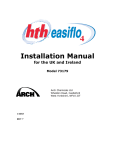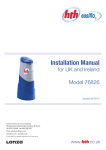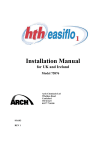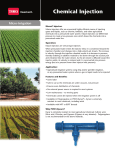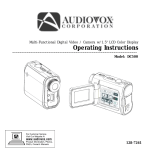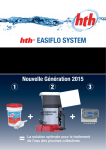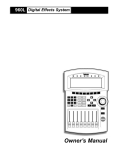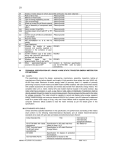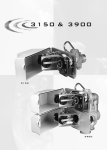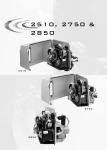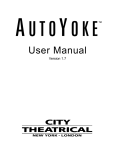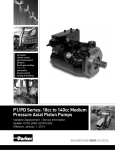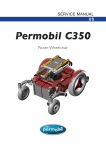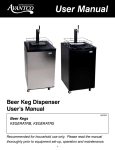Download Installation Manual - Pool And Spa Centre
Transcript
Installation Manual for the UK and Ireland Model 71945 Arch Chemicals Ltd Wheldon Road, Castleford West Yorkshire, WF10 2JT 7/15/05 REV 11 Product Stewardship MAKING THE WORLD A BETTER PLACE Arch is committed to maintaining and improving our leadership in Product Stewardship. One of the six initiatives outlined under the Chemical Manufacturers Association (CMA) Responsible Care® Program is to make health, safety, and environmental protection an integral part of a product’s life cycle from manufacture, marketing, and distribution to use, recycling, and disposal. Successful implementation is therefore, a shared responsibility. Everyone involved with the product has responsibilities to address society’s interest in a healthy environment and in products that can be used safely. We are each responsible for providing a safe workplace. All who use and handle products must follow safe and environmentally sound practices. For more information about our Product Stewardship Program, contact your Arch Representative. 2 SITE SURVEY When conducting the site survey and in discussions with the pool operator decide which type of installation will be carried out. A single pool installation can be carried out in one of three ways:1. As described in the manual, using the venturi and booster pump to evacuate the chlorine solution produced by the feeder into the circulation line of the pool. 2. The chlorine solution can be evacuated instead by the use of a conventional dosing pump. 3. Using a venturi which employs the motive power of the pools’ own circulating pump. In this instance consultation with Arch technical services is necessary to advise on feasibility. For multi pool installations – again the venturi and booster pump can be employed to evacuate the chlorine solution into the largest of the pools on site. For additional smaller pools a conventional dosing pump can be used to extract and inject chlorine solutions from the discharge tank of the feeder. Ensure an adequately sized pump is employed. Entry to the discharge tank can be gained by drilling an access hole close to the top of the tank ensuring the hole and subsequent suction line to the pump does not interfere with the discharge valve arm or float. The dosing pump should be selected carefully realising that the chlorine solution produced is only around 1.5% of available chlorine. Approximate sizing of pumps for different sizes of pools are as follows: Up to:100m3 = 30 l/h 100 – 200m3 = 50l/h 200 – 300m3 = 75l/h Count 25l/h for each additional 100m3 3 Instructions for Easiflo® 3 Booster Pump Installation To simplify installation: Please read this installation manual completely before going to the pool site. Equipment needed to install: Drill – Cordless recommended PVC Pipe Fittings (as required) PVC Primer/Cleaner PVC Glue Saw to cut PVC Pipe Electricity for the pump (240V)/20 Amp 11/2” PVC pipe (length will vary) PTFE tape Tube cutters or Utility Knife Silicon thread sealant 2 Pipe Wrenches or Gas Pliers (Channel Locks) Water tight connectors for pump wiring Wire for pump (14gauge minimum required) Pressure gauge Saddle clamps (optional) Solenoid valve - we recommend a ……….. In line filter – we recommend a ………….. available from Prominent The following parts are included with the feeder: One 1/2” BSP male x male grey ball valve One 1/2” BSP male x female grey ball valve 1 /2” O.D. LDPE tubing Two 1/2” closed PVC nipples Two 1/ 2 ” Female Parker tube fittings One Scoop (P8FC8) One Venturi Not included with the feeder: A booster pump is not included with the feeder. In order to get the optimal performance out of the feeder and the reliability from the pump, we recommend the following pump: Sta-rite 1.0 HP pump reference S5P2RE1 available from SCP UK – tel: 01293 546 126 Alternatively Sta-rite 5P2RE1, can be used. However, for reliability we recommend the pump seal is changed to silicon carbide. These seals have the part number 17304-0100. Overview A 11/2” loop is going to be added to the main pool recirculation line. The loop will have an in-line Easiflo® pump to drive a venturi. The Easiflo® 3 inlet line will get water from the discharge of the Easiflo® pump. The discharge valve of the chlorinator will be hooked up to the venturi. The Easiflo® pump provides the correct pressure (~ 35 psi) to drive the jets in the manifold of the Easiflo® 3 chlorinator. It also provides correct flow through the venturi to create a vacuum to evacuate the chlorinator. This installation method gives optimal performance of the Easiflo® 3 chlorinator in most above and below grade installations. The use of a pressure gauge on the discharge side of the pool pump after the filter is recommended for correct installation of the system. 4 Easiflo® System Site Assessment It is critical to determine the effluent pressure of the system prior to installation. This pressure must be measured immediately after backwashing when it will be at its highest level. Refer to the appropriate system diagram in the back of this manual to determine where to measure this pressure (P1). Take a pressure reading and refer to the graph to determine the suction capacity of the system assuming that there is no suction lift correction. Record this suction capacity as F1. Next, determine where the Easiflo pump and venturi loop will be installed. Always minimize the backpressure on the venturi. Avoid use of elbows after the venturi if possible. Never install an elbow within 3 feet of the venturi outlet. Always use elbows on the inlet to the Easiflo pump or prior to the venturi if possible. After the evacuation system has been laid out, measure the height differential (in feet) between where the venturi will be installed and discharge valve of the Easiflo chlorinator. Use this height differential to calculate the suction lift factor in the formula that follows. The greater the height differential the more suction you will lose from the venturi. Next calculate the outlet flow using F1 and the suction lift factor. The minimum outlet flow required is 8.7 litres per minute. Suction lift factor = (34 – height differential in feet) / 34 Example: height differential is 6 feet, therefore Suction lift factor = (34-6) / 34 = 28 / 34 = 0.82 Take the suction capacity F1 and multiply it by the suction lift factor to get the actual outlet flow. The formula is: F1 x suction lift factor = actual outlet flow Example #1: Assume that the pressure measured in the pipe is 12psi. Using the P4 graph 1 in this manual the outlet flow (F1) is determined to be 14.4 litres per minute. F1 x suction lift factor = actual outlet flow 14.4 lt/m x 0.82 = 11.7 lt/m = actual outlet flow (This flow is acceptable) It is above 8.7 lt/m which is above the minimum. Example # 2: Assume that the pressure measured in the pipe is 25psi. Using the P4 graph, the outlet flow (F1) is determined to be 10.2 lt/m F1 x suction lift factor = actual outlet flow 10.2 lt/m x 0.82 = 8.33 lt/m = actual outlet flow (This flow is insufficient to drain chlorinator) It will be necessary to use 11/2” shut-off ball valves in the booster pump/venturi loop. Refer to Graph #4 to determine suction capacity @ 25 psi with 11/2” ball valves. Now determine where the power source will come from for both the booster pump and solenoid. These considerations will help determine the length and gauge of wire needed. The last consideration for the site assessment is the fill/tap water source and the type of pH control system to be used. If Carbon Dioxide will be used for pH control, it may be preferable to provide the inlet flow to the chlorinator from the fill water source. Typically, Carbon Dioxide pH control systems will raise the Total Alkalinity of the pool water to well over 100 ppm. This TA level will increase the tendency for scale formation in the chlorinator. Consequently, it is recommended that the inlet flow be provided from the fill water source if the TA of the fill water is below 100 ppm. The use of fill water to the chlorinator inlet will add water to the pool on a daily basis in relatively small amounts. A typical indoor 375m3 pool will use approximately 75 litres of chlorinated solution from the Easiflo System per day. A typical outdoor 375m3 pool will use approximately 225 litres of chlorinated solution from the Easiflo® System per day. The Easiflo®3 System also puts an additional 3.3m3 of water a day in the pool from the wash-down system. If you use this installation method make sure that the pool has that amount of water being removed as to not cause the pool to overflow. Fill water systems typically operate at pressures between 50-80 psi. This pressure is too high for the Easiflo® System valves to operate properly. It is therefore necessary to install a pressure regulator on the inlet flow to the Easiflo® system. This regulator must be installed directly at the fill water source. This will insure a reduced pressure in the flexible polyethylene tubing and solenoid valve on the inlet side of the chlorinator. Adjust the pressure regulator to provide between 30-35 psi inlet water pressure. See diagram below for proper fill water plumbing hook-up. Direction of Flow Fill water Source Pressure Regulator 0-60 psi Inlet Shutoff Valve Easiflo 3 Inlet Pump The 3/4 H.P. pump is wired for 240V. The power supply to the Easiflo pump must be interlocked to the pool recirculation pump. This is to prevent running the Easiflo pump dry when the pool pump is shut off. Use watertight connectors when wiring the pump. Installation of equipment Place the equipment, pump and chlorinator, in the poolroom in a convenient location. Shut off the pool recirculation equipment before proceeding with the installation. Review the installation diagram prior to installation. Dealer Installation Notes: Suction Capacity, "GPM" Graph Pulsar®33Installation Graph #3: #3: Easiflo Installation 3/4 HP Pump withwith 1585X Mazzei 3/4Booster HP Booster Pump 1585X Mazzei Venturi 1” Ball Valves Venturi and and 1" Ball Valves 4 3 2 1 0 0 10 20 Pool Return Pipe Pressure, "PSI" 30 ® 3 Installation Graph#4: #4:Easiflo Pulsar Graph 3 Installation 3/4HP HPBooster BoosterPump Pumpwith with1585X 1585XMazzei Mazzei 3/4 Venturi and and 1111/2" BallValves Valves Venturi /2” Ball Suction Capacity, "GPM" 4 3 2 1 0 0 10 20 Pool Return Pipe Pressure, "PSI" 30 1. Based on your site assessment, drill and tap a 11/2” BSP hole down stream of the pool filter and heater. Note: You can use saddle clamps if you wish. This is one of two holes that will be needed in the installation. The hole should be drilled on the side or bottom of the pipe, if the pipe is horizontal. NOT ALL PIPES RUN FULL. 2. Cut both of the 12” x 11/2” PVC nipples in half. (4 pieces). Take one of the pieces and apply PTFE tape to the threads. On top of the PTFE tape add a silicon seal bead around the threads. The silicon seal helps to make a good seal. Wipe off any excess. 3. Thread the nipple into the 11/2” tapped hole or saddle clamp. 4. PTFE tape the 2” X 11/2” reducer bushing and screw and tighten it securely into the inlet of the Easiflo pump 5. PTFE tape the threaded end of one of the nipples that was cut in half. Place a bead of silicon seal around the taped threaded ends. 6. Screw and tighten the two pieces into the inlet and outlet of the Easiflo® pump. 7. Take the 11/2” ball valve and glue it onto the nipple that has been screwed into the pool piping in step #3. This is what makes the connection from the pool recirculation system to the Easiflo pump inlet using 11/2” PVC piping. 8. Drill and tap another 11/2” BSP hole downstream of the first hole that was drilled and tapped. This hole accommodates the discharge side of the Easiflo® pump. If automated controllers are used in the system, the drilled and tapped hole must be placed downstream of the auto control feed point. This is to avoid problems that may occur with the controller operation. See installation diagram. Thread one of the cut 11/2” nipples into the 11/2” tapped hole or saddle clamp. 9. Take the 11/2” ball valve and glue it onto the nipple installed in Step 8. Please make sure that there is a straight connection back into the pipe, no elbows. This is to connect the pool recirculation system to the discharge side of the Easiflo® venturi. 10. Tie in the electrical to the Easiflo pump making sure you have the pump configured for the correct voltage. 11. Using 11/2” PVC piping, connect the inlet side of the Easiflo® pump to the 11/2” ball valve installed in step 7. 12. Piping the discharge side of the Easiflo® pump will involve installing a venturi and reducing tee. See Figure 1 for a reference. Place and glue the 11/2” x 1/2” reducing tee on the 11/2” cut nipple on the discharge side of the pump. This reducing tee will have a 1/2” male x male ball valve screwed into it that will provide the inlet water to the chlorinator. 13. Take the black venturi and PTFE tape all the threaded ends. Take the two unions (makes for easy removal of venturi, for cleaning, after installation) and screw one on each end and tighten. Take and thread the 3/4” x 1/2” reducing union to the venturi. 14. Connect the venturi as close as possible to the ball valve installed in step 8 using a short section of 11/2” PVC pipe. Make sure the flow through the venturi is in the proper direction. Connect the other end of the venturi to the discharge side of the Easiflo® pump using 11/2” PVC pipe. 15. 16. 17. 18. 15. The recirculation loop is now complete. 16. Now hook up the Easiflo 3 feeder to the Easiflo® recirculation loop. Two 1/2” BSP grey ball valves have been included with the feeder. One is a 1/2” x 1/2” male valve which is screwed into the reducing tee, which is located on the discharge side of the Easiflo pump. Connect the 1/2” tubing from the flow indicator to the inlet on the Easiflo WARRANTY POLICY ® Easiflo 3 Commercial Pool Chlorinator The Easiflo® Chlorine Feeder comes with a 12 month warranty from the date of installation. In order for the warranty to be validated the Warranty Registration Document W2 must be completed and returned to Arch Water Products, Wheldon Road, Castleford WF10 2JT. Easiflo 3 Feeder Detailed View 2 3 4 1 24 36 Op era tor ’s 26 28 25 5 Ma nu al 17 7 8 47 56 60 6 9 47 21 30 13 8 28 13 11 26 28 13 10 37 9 20 19 18 38 rev 12-02-02 18 27 37 17 42 11 39 12 38 41 14 15 45 30 (not included) 16 38 32 42 33 29 40 31 44 39 15 23 43 10 22 rev 12-02-02 Installation Kit flow to pool 12 6 4 Pu lsa Ins tall ati on r3 Ma nu al cut 1½ “ PVC pipe (installer provides) 7 3 2 flow er feed m o fr 3 5 flow r ede e f o t cut 1½ “ PVC pipe (installer provides) 1½ coupling slip x slip (installer provides) 6 1 flow ol po from rev 12-02-02 6 4 1½ coupling slip x slip (installer provides) cut 1½ “ PVC pipe (installer provides) Easiflo 3 Diagram Number Part Number 0 1 71528 71608 1 Easiflo 3 System, PS 5000-Includes Installation Kit 1 Hinge Rod W/Set Screw for E3 Hopper 2 3 71607 71609 1 1 Lid for E3 Briquette Screen Assembly for E3 4 71606 1 Hopper without Lid for E3 5 6 71619 71617 2 3 Elbow (P6ME6) 3/8" For Feeders 30991 & E3 Spray Nozzle for E3 7 8 71616 71620 1 1 Manifold for E3 Deflection Plate Assembly 9 71610 1 Base without assembled parts for E3 10 11 71615 71536 1 1 Discharge Valve Body with Plug, Ball & Gasket Emergency Shut Off Mounting Plate 12 13 71535 71537 1 4 Emergency Shut Off Valve with Arm Only Emergency Shut Off Mounting PVC Screws(1/4x20x2 1/4) 14 71539 1 Emergency Shut Off Float Plate 15 16 71538 71540 1 1 Emergency Shut Off Float Plate PVC Nut/Discharge Arm Nut Emergency Shut Off Overflow Float 17 71496 0 Emergency Shut Off Valve Assembly - Part 71910 Not Included 18 19 71583 71613 2 1 Discharge Valve Locknut (4026) O-Ring #115 - Used in Plug 20 21 71612 71558 1 Plug for Feeder Body for E3 3/8" O.D. Polyethylene Tubing - 20' 22 71584 1 Discharge Valve Arm with Suction Cup 23 24 71585 71614 1 1 Discharge Valve Float Tube Connector (P8MC4) for E3 25 26 71621 71626 1 1 1/2" Ball Valve MM (Inlet) 20' 1/2" O.D. PE Tubing(P4 only need 3 inch piece) 27 71627 1 1/2" Ball Valve MF (Outlet) 28 29 71588 71611 3 1 (5008) 1/2" X 1/2" Female Connector (P8FC8) 1/2" X close PVC Nipple 30 31 71910 72863 1 1 Rubber Gasket for Emergency Shut Off Valve Discharge Valve Enhancement Adaptor 32 71925 2 8 - 32X5/8" PVC Screws 33 34 72865 71373 2 Custom Washer for Discharge Valve Adapter 1 Cleaning pan for Briquette Grid (Easiflo 3) 1/8/2003 Qty Description Note: Items 29 through 32 are not shown Easiflo 3 Diagram Number Part Number 35 36 71598 71622 1 (8001) Scoops (Easiflo Accessory) 1 Operators Manual for E3 System 37 38 72864 71900 0 1 E3 Enchancement Kit Parker fitting W6ME4 39 71968 2 1/4" Threaded PVC Tee with Nipple 40 41 72862 71572 1 1 Spray Nozzle (Lechler 632.364.5E.BC) (3045) Reducing Bushing (3/8"x1/4") For Feeder 30025 (PPI)&E3 Enhancement K 42 43 71582 72861 2 1 (4014) Parker Fitting P6MC4 Spray Nozzle (Lechler 632.564.5E.BC) 44 71563 1 (3002) PVC Elbow For Feeders 30025, 30991and P3 Enhancement Kit 45 71574 1 (3103) 3/8" P.E. Tubing E-64-0500 (13.5") 1/8/2003 Qty Description Note: Items 29 through 32 are not shown ISSUE 1 SPRING 2003 ARCH WATER PRODUCTS RESPONSIBLE CARE GUIDANCE NOTE AWP RC 2003/1 EMERGENCY RESPONSE PROCEDURE FOR ARCH WATER PRODUCTS CUSTOMERS 1 In the event of a Health Safety or Environmental Emergency involving Arch Water products. This includes • Injury to persons requiring medical treatment • Loss of containment of product to the environment • Involvement of the Emergency Services (Police, Fire, Medical) • Involvement of the Environmental agencies • Major damage to property FIRST TELEPHONE + 44 (0)1865 407333 This will connect you with the NCEC (National Chemical Emergency Centre) who support the Arch Emergency Response. (It operates 24 hours a day, 365 days a year). THEN Phone your local Arch Water Products Office (during office hours) 2 NCEC will provide initial assistance and advice (in English). 3 NCEC will also contact Arch Water Products Head Office. 4 When calling the Emergency No. have the following information available (use your Emergency Response Procedure Checklist): • Your name • Your job title • Your company name and location • The Telephone (and fax) number that you can be contacted on • The Product Name • The Product Code • The nature of the emergency • The action you have taken • Are the emergency services involved? • Are the environmental agencies involved? PLEASE ALWAYS CONTACT NCEC IN THE EVENT OF A HEALTH, SAFETY OR ENVIRONMENTAL EMERGENCY INVOLVING ARCH WATER PRODUCTS BUT PLEASE ONLY USE THIS NUMBER FOR HEALTH, SAFETY AND ENVIRONMENTAL EMERGENCIES (as defined above).























